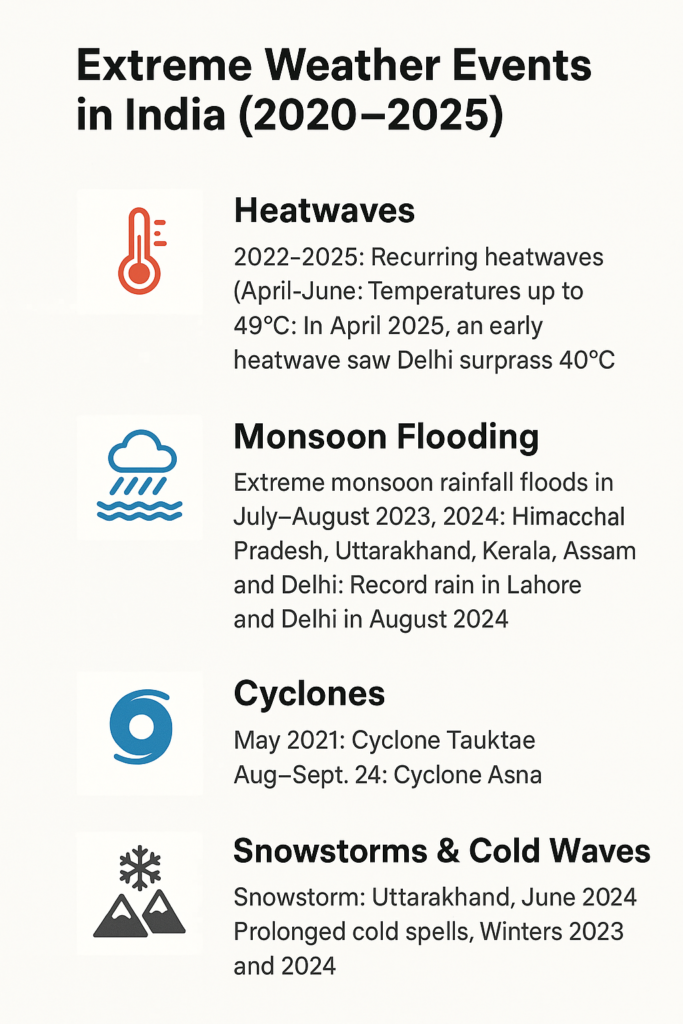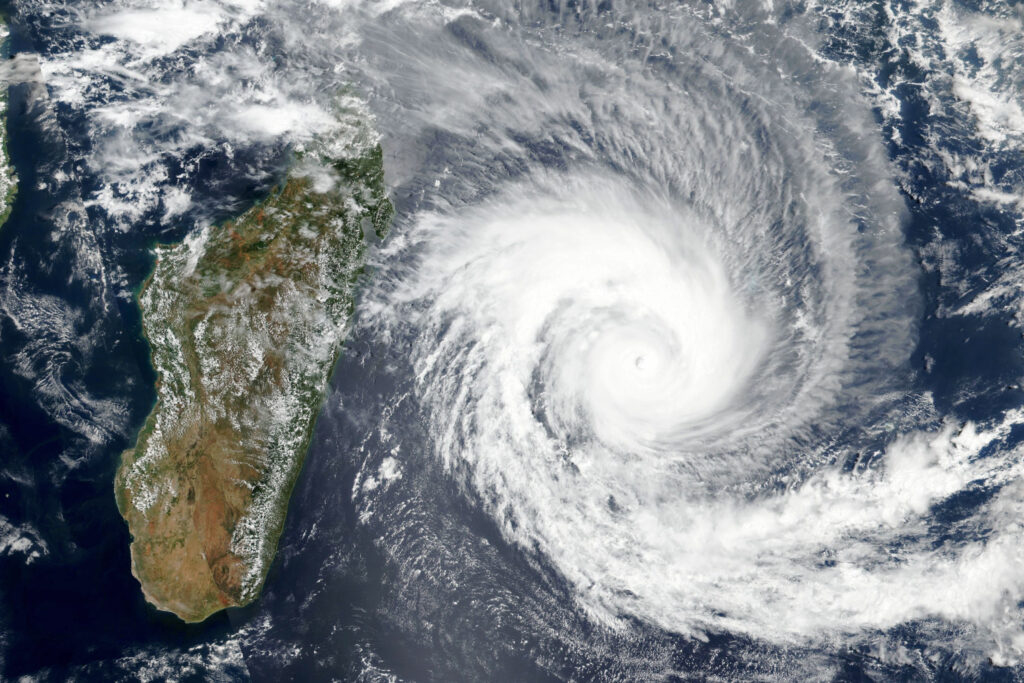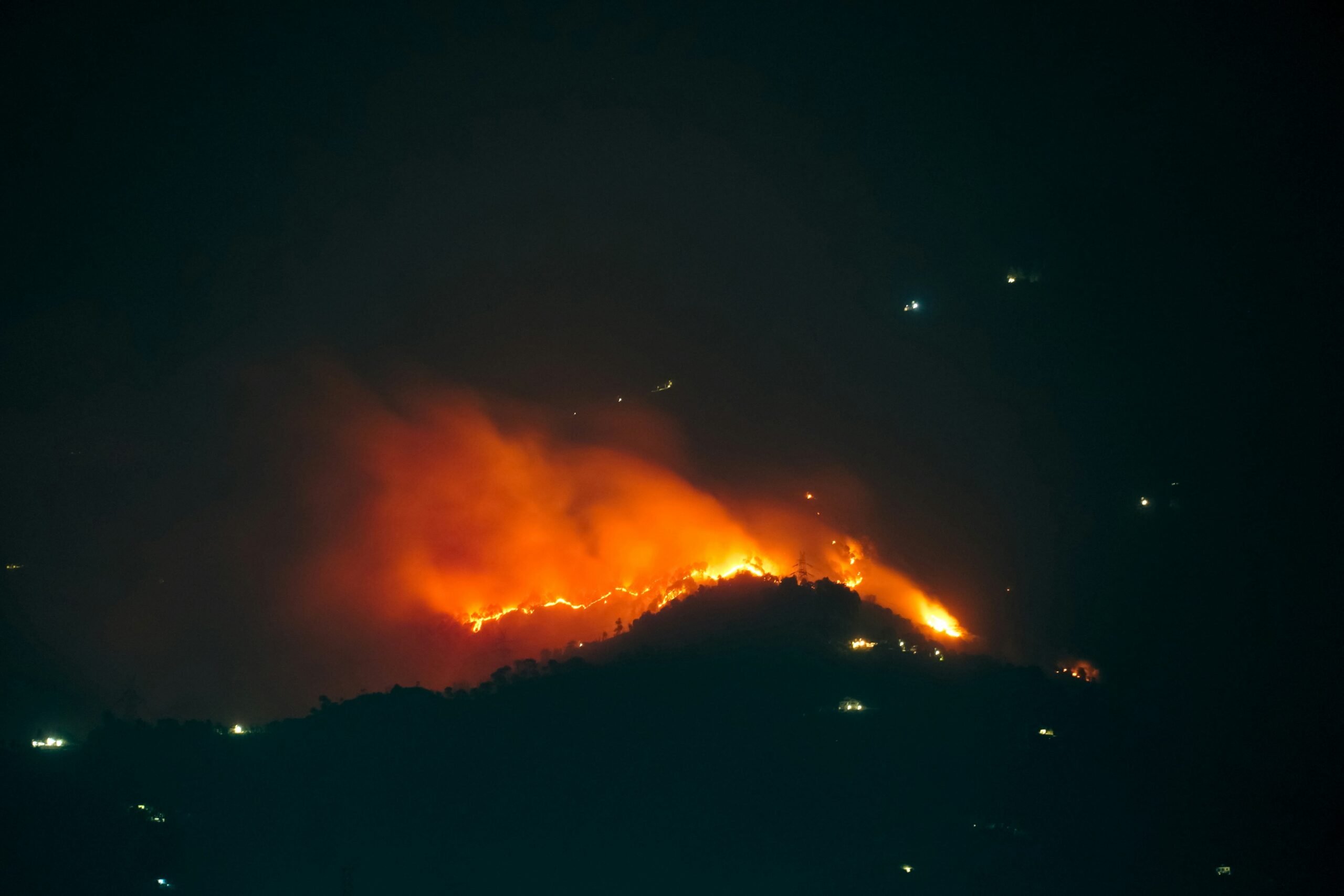Extreme weather events in India (Climate Change)
Rising temperatures Rising Alarms
Over the last few years, India has been at the mercy of climate change and extreme weather events. There have been various incidents of heatwaves, hailstorms, flash floods, etc., at various places at various times. With every passing year, their frequency has been increasing, which is alarming and a cause for concern. The article shares some of the extreme climatic events that struck India in the last five years.
India saw extreme weather events on 255 days in the first nine months of 2024, as against 235 days for the same period in the year 2023 and 241 days in 2022. At least 3238 people lost their lives due to these events in 2024 compared to 2755 in 2022. 3.2 million hectares of land were affected in 2024 compared to 1.84 million hectares in 2022.

Here are a few incidents that show how the weather pattern has changed in India in the past five years. Some of which are extreme.
Heatwaves (Scorching Summers: the new normal)
- The early start of summer has added more summer days to the usual summer cycle in India. Now summer starts early in the month of March itself.
- Temperatures are soaring to 45°C in various regions like Delhi, Rajasthan, and Uttar Pradesh. The same has been observed since 2020.
- In 2025, Delhi recorded a temperature of 40°C in April itself.

- Areas like Churu and Phalodi in Rajasthan observed a temperature of 46°C in 2021.
- India observed the hottest March in the year of 2022 since records began in 1901.
- The state of Bihar observed 18 heatwave days, up from six in the year 2023.
- In 2023, each person was exposed to 2400 hours per year when light to moderate outdoor activity resulted in a risk of heat stress.
- Heat exposure in 2023 caused the loss of 181 billion potential labor hours, resulting in economic losses in addition to health hazards.
- Rising sea levels in coastal areas triggered migration of around 18.1 million people in India residing in areas less than one meter above the sea level.
- In recent times, cities like Bangalore and Delhi have witnessed fights over water due to scorching summers.
Monsoon (when rain, rain go away doesn’t work)
- Maharashtra has been experiencing catastrophic floods and landslides due to extreme rainfall in the past few years. This has led to overwhelmed drainage, killing lots of people, and infrastructure damage.
- In 2022, torrential rains caused severe flooding in the states of Assam and Meghalaya, affecting a lot of villages and destroying hectares of land.
- In 2023, there was a lake outburst in South Lhonak Lake, Sikkim, leaving a lot of casualties.

- Some parts of northern India in 2023 received unprecedented rainfall, with some areas receiving 30 cm of rainfall in a single day.
- Over the past few years, Delhi has been receiving a lot of rainfall, causing infrastructure damage.
- There was a series of landslides in the Wayanad district of Kerala in 2024, resulting in devastation. Official data indicates that over 420 people died, and many were injured.
- During the month of August in 2024, Jaisalmer received 55 percent of the season’s rainfall in a single day.
Cyclones (the coastal fury)
Warmer sea temperatures in the Arabian Sea are fuelling stronger cyclones. Loss of mangroves and urbanisation are also contributors.

- CYCLONE AMPHAN (May 2020)
- It affected the states of West Bengal, Odisha, and Bangladesh.
- Strongest storm to hit the Bay of Bengal since 1999.
- It killed around 100 people with damage of around $13 billion.
- CYCLONE TAUKTAE (May 2021)
- It affected Kerala, Goa, Gujarat, Maharashtra, and Karnataka.
- The disaster left approximately 174 people dead and displaced 200,000.
- It was one of the strongest cyclones to hit the western coast of India in decades.
- CYCLONE YAAS (May 2021)
- Odisha, West Bengal, and Jharkhand were the impacted states.
- The event displaced 1.2 million people, and reports counted 20 deaths.
- CYCLONE MANDOUS (December 2022)
- Tamil Nadu and Andhra Pradesh were the impacted states.
- It brought high-intensity rainfall, which caused urban flooding in Chennai and surrounding areas.
- CYCLONE BIPARJOY (June 2023)
- The cyclone affected Gujarat and Rajasthan.
- It was one of the longest cyclones lasting over the Arabian Sea (for around 10 days).
- The evacuation involved around 100,000 people.
- The disaster caused intensive flooding in the Kutch region of Gujarat.
- CYCLONE ASNA (August-September 2024)
- It affected the states of Gujarat, Rajasthan, and Madhya Pradesh.
- It left 49 people dead.
- The cyclone caused excessive flooding in the region of Gujarat.
In recent years, the Arabian Sea has also seen an increase in cyclonic activity due to an increase in temperature. The cyclones generally intensify in 24-48 hours, giving less time to prepare. Also, cyclones are penetrating inland, affecting more and more states. These cyclones not only bring destruction but also cause economic imbalance.
Snowstorm and Cold waves (Unseasonal chill in the air)
- In January 2020, a cold wave hit northern India, impacting Delhi, Punjab, Haryana, Uttar Pradesh, and Rajasthan. Delhi recorded its coldest day in the past 100 years with the temperature hitting 1.1°C.
- Jammu and Kashmir, Uttarakhand, and Himachal witnessed heavy snowfall in February 2021. The snowfall exceeding monthly averages triggered avalanche warnings. There were landslides in the Kashmir valley.
- Delhi recorded its coldest December 2021. The temperature in Rajasthan reached 3°C.

- In January 2023, Gulmarg in Kashmir received 8 feet of snow in just 4 days, which caused the ski resorts to temporarily shut. The blocked roads due to snow isolated Srinagar.
- An intense cold wave hit the Indo-Gangetic region in January 2024, with night temperatures hitting 2-4°C. The cold wave impacted Bihar, Uttar Pradesh, and Madhya Pradesh.
- Winter extended till the month of March in early 2025, impacting the wheat harvest. Dense fog engulfed in February.
Winters are becoming longer, and cold spells are becoming erratic. Arctic warming is causing long, cold spells in northern India. Most importantly, these events are becoming more frequent and unpredictable in nature, causing devastation.
Hailstorms (A threat to the crops)
- During March 2020, Maharashtra and Madhya Pradesh were impacted by hailstorms. Wheat, gram, and mustard crops were affected before harvest.
- Rabi crops were affected during February and March 2021 in the states of Punjab, Haryana, Uttar Pradesh, and Rajasthan.
- Onion, sugarcane, oranges, and wheat crops were affected in the states of Maharashtra and Telangana during the March 2022 hailstorms.
- Sudden hail and high winds hit gram, wheat, and mango orchards in the states of Madhya Pradesh and Chhattisgarh during March 2023.
- Hail impacted various states of India throughout the year 2024, impacting wheat, chana, mustard, and banana plantations.
These weather events are the new normal for India. Record-breaking heatwaves, cold waves, and snowstorms are happening more frequently than the communities can adapt to. These are not just meteorological anomalies but deep-rooted stories of displaced human communities, lost livelihoods, and devastated crops. There is an urgent need for disaster preparedness, climate-resilient infrastructure, and planning. It is time to change the narrative and act upon what is required because
There is no PLANET B

Books to read:

